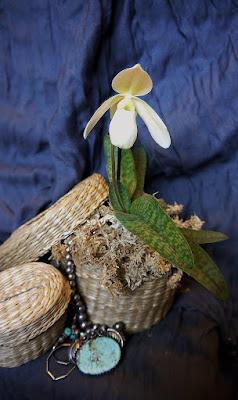Paphiopedilum Deperle is a hybrid in the genus Paphiopedilum. This hybrid is made using Paphiopedilum delenatii (native to Vietnam and have white flowers with a pink lip) and Paphiopedilum primulinum (native to Indonesia and have yellow-green flowers).
Paphiopedilum Deperle is a hybrid in the genus Paphiopedilum. This hybrid is made using Paphiopedilum delenatii (native to Vietnam and have white flowers with a pink lip) and Paphiopedilum primulinum (native to Indonesia and have yellow-green flowers).
IDENTIFY PAPHIOPEDILUM DEPERLE ORCHID PLANT
Paphiopedilum Deperle comes in two colour variations as does its parents. There is a Deperle Alba cross and a Pink cross. Both being very unique and beautiful in it's own individual way.
The plant, relatively large, can reach a height of 25 cm. Its roughly elliptical leaves (13 cm by 5) are of a rather light green, tessellated with dark green. The inflorescence, about 20 cm long, bears many flowers, with a diameter of about 10 cm, which open in succession. Ivory, the petals and sepals are elongated, while the lip is relatively big.
PAPHIOPEDILUM DEPERLE ORCHID PLANT CARE AND CULTURE
Cultural information should only be used as a guide, and should be to be adapted to suit you. Your physical location; where you grow your plants, how much time you have to devote to their care, and many other factors, will need to be taken into account. Only then can you decide on the cultural methods that best suit you and your plants.
Light:
Paphiopedilum Deperle orchid loves the bright sun without access to direct sunlight, so at the time of the midday solstice it must be placed behind the curtain or in the shade of other plants.
Temperature:
This hybrid belongs to the moderately warm temperature regime: Summer temperature at 17-30 ° C; Winter at 14-21 ° C. For successful cultivation at home it is necessary that the nighttime temperature is always 4 ° C lower than the daytime.
Humidity:
Paphiopedilum Deperle is not demanding of high humidity, 50-70% will be enough for normal growth and development of the plant. However, at temperatures above 27 ° C, it is desirable to increase the air humidity to at least 70%, since too dry air adversely affects the roots and leaves of the plant. To increase the humidity of the air, you can use a humidifier, water saucers or wet clay. For this, a large pallet is taken, inside of which expanded clay is poured, a grate protecting the wetting of the roots is placed on top and pots with orchids are set. The higher temperature, the higher the humidity should be, and the higher the humidity, the more often and longer it is necessary to ventilate the room where orchids are contained, otherwise the probability of rotting and leaves of various kinds of fungi.
Substrate, growing media and repotting:
Paphiopedilum Deperle are grow only in a pot. A mixture of bark of coniferous trees with peat is best suited as a substrate. In addition, it is strongly recommended to add lime to the substrate. Practically not exhausted source of lime are seashells, which can be thoroughly washed from salt, crushed and poured into the substrate.
Repot this hybrid annually. The best time for this is spring - the beginning of a new growth. A very important point here is the height of planting. If the plant is planted incorrectly, for example, too high, then the roots of an orchid will hang in the air and stop growing. The substrate should cover the upper red-and-white part of the plant for 1-2 fingers, and in no case should it be tamped down, because if the substrate is too dense, the orchid can simply suffocate. When planting, you need to take care of a thick layer of drainage to keep the orchid from stagnating water inside the pot.
Watering:
This orchid hybrid needs frequent and abundant watering throughout the year. Excess water during irrigation should flow freely from the pot, since stagnation of water both inside the pot and in its pan can very quickly lead to rotting of the roots and the lower part of the plant. The substrate between waterings should dry relatively well, but not dry completely. Long-term stay of completely dry (2 or more days) is not acceptable. After watering, the water from the leaves must be removed with a tissue.
Spraying the outer part of the plant at home does not lead to anything good, because the structure of its leaves resembles a funnel, and water constantly accumulates in the core of the plant, which can very quickly lead to rotting of both peduncles and the core itself.
Fertilizer:
During the period of new growth fertilize this type of orchid once every 2-3 weeks in the usual concentration of fertilizer indicated on the package. A NKP 30-10-10 fertilizer is recommended.
Rest period:
Paphiopedilum Deperle does not need a rest period to stimulate flowering, so the given conditions should be maintain all year round.
This hybrid can bloom at almost any time of the year, with the exception, perhaps, of summer. Flowering occurs during a period of new growth on last year's sprouts.
After flowering, the peduncles are removed, if necessary, the orchid is transplanted and kept relatively dry for some time. This is necessary to acclimatize the plant and to prevent wound rotting on the roots resulting from the transplant.















COMMENTS